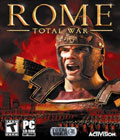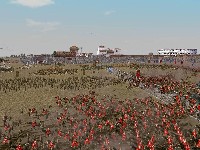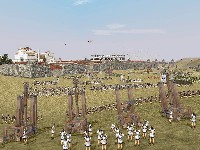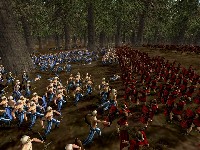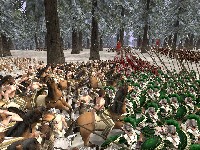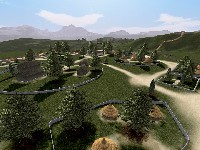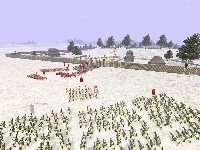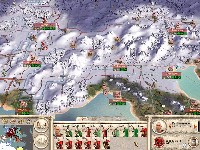Genre: Strategy
Publisher: Activision
Developer: The Creative Assembly
Release Date: September 22, 2004
Buy 'ROME: Total War': PC
It's 328 B.C. Your children are coming of age. After decades of service in the Legions of Rome, it's finally your turn. How many times have you nearly died for this great empire? The scar on your neck is evidence enough. After standing against incredible odds, you almost bled to death on that field, and with the ensuing infection, it was nearly six months before you regained the strength to leave the house.
Today, it is all finally worth it. After assuming control of two cities in the north of the peninsula, the Senate has finally sent orders for you to take control of a nearby city and govern it, your first chance to lead the expansion of the Roman Empire! Truly, it is a momentous day, as this is the first step to becoming a dominant presence in Rome and influential to its senate. Some day, you may even gain the strength to become Emperor, and repay the Senate for the many times they have passed you over before this day. It is a wonderful day, indeed.
Welcome to Rome: Total War. Designed around the Roman Empire circa 250-300 B.C., RTW incorporates many of the complexities of Roman society as a game where the strategy is to build a sphere of influence that eclipses all others. Rome was one of the greatest civilizations to rule in the history of the world, and the Empire stretched beyond modern comprehension when considering their primitive technological and communication abilities. What they did have was physics and an insatiable drive to succeed. By using logic, philosophy, physics, and immeasurable sweat equity, the Roman Empire built roads, aqueducts, coliseums, and an army and navy to dominate much of the Mediterranean. Without so many things we take for granted today, Rome evolved into a massive state, and the first great democratic republic.
Creative Assembly has created a highly customizable gaming experience that capitalizes on the essential elements of power politics and military strategy of the Empire of Rome. In RTW, not only do you experience all of the amazing military and civil capabilities of an ancient culture, but the game also provides an opportunity to direct the development and growth of the Empire.
RTW incorporates civil development with military battles, no new theme to the gaming community. The complexity and comprehensive nature of both the strategic and battle elements of RTW truly define it as a game which has raised the genre standard for all others to meet. The majority of the strategy for RTW takes place in the turn-based action of the over-world, with decisive real-time battles determining your progress in the game.
The tutorial gets the action going very quickly, and the controls are easy to learn, but the second battle makes it pretty clear that combat skills are essential to become more powerful than the regional thug. With that in mind, the main story mode is to complete your rise to Emperor. Other gaming options include historical battle scenarios and multi-player combat modes that support up to eight players.
The essential element to advance in story mode of RTW and the basis for multiplayer and historical recreations is live combat. The obvious improvement in Rome for the combat engine is the individual units on the battlefield, as the units are now 3D soldiers and machines, making combat a full 3D experience. Not only do units look far better than the 2D sprites of the past, but the omnipotent camera angles also make for amazing views of the action. It is possible to send your units into battle and then zoom in at ground level, yielding a view exactly as if standing right in the center of the action.
If the scenes from battle look familiar, it is because you may have seen the RTW engine in action on TV, recreating historic battles for documentaries. But in practice, does it really look that good? Our experience with the battles tested the actual operability of the engine on a standard platform with a less-than-optimal Celeron 1.8GHz with 768MB of RAM and a Radeon 9800 card. We threw 7500 men into a massive melee battle, and to look all around from the center was an amazing visual experience. There were some hiccups, but we dropped some of the extra visualizations, and operation was fairly smooth.
Swapping the Celeron for a P4 2.2GHz, performance was greatly improved, and the battles were smooth with all visual options enabled. With a potential of over 10,000 units on the field at once, RTW has raised the bar for definition and complexity possible in a combat experience. To sit back and watch units with 100 individual characters do battle, each attacking and defending as a real soldier would in battle is pretty cool, to say the very least.
The Senate gives directives for the growth of the empire, usually requesting war on enemy cities. In success are the spoils of gold, popularity, and increased political power. In order to find success, economic power is necessary from existing territories under your control to fund and develop military operations. Rather than one overarching ministry of defense, each city must build the necessary capability for combat unit production, and management of each city's improvements and taxation determines total productivity, which makes capitalization of the unique strengths of cities very important. RTW makes it very easy to go bankrupt through inefficient civil development. Utilizing high tax rates on passive populations and upgrading military facilities at certain cities that build the most deadly units produce greater returns on lower investments. A development strategy implemented identically on each city will bring defeat, and it will come swiftly.
After mastering control of effective development, further influence on the productivity of each city is the governor, primary characters that may also lead battle forces in the field. These characters have unique attributes, suiting some better for the field, and others to manage affairs of the cities. For fun, we swapped a strong city manager with a brave warrior, and the result was that the troops were less confident in combat. This led to more units fleeing the battlefield and less effective attacks by our troops in the presence of the weak leader. In the city, growth and profitability slowed under the warrior, although the masses were less likely to revolt or create trouble.
Control of the many options is thankfully presented in a fairly logical arrangement, making the game easier to learn than most, albeit very difficult to master. This means that frustration comes from not having the finesse to outflank an opponent, rather than not being to execute the commands despite knowing how to succeed. By the time the tutorial is complete, all of the basic operational and battle techniques are well described, and it is now up to the player to begin making - or taking - of Rome what they can.
Battle in RTW is much more complex than dropping a few thousand units on a battlefield and waiting for everyone to duke it out. The battlefield maps are very large, making fatigue, positioning, and timing very important factors. As we played one of the alternate game modes, recreating a historical battle against a trap laid by Hannibal, it was necessary to pause the game often and issue commands because of the speed and intuition needed to find success when the enemy is always moving in response to your actions. Making the challenge to succeed ever more difficult is strategic utilization of specialty units, like War Dogs, enable a fairly even matched battle to be turned into a decisive routing of the enemy. As an example, the War Dogs create panic within the ranks of the enemy to break their ranks and increase fear. Another impressive group is the heavy cavalry, who can charge in and wipe out swaths of infantry in an instant, but to get them back out of the fray for another deadly charge proves to be as difficult as it would most likely be in a real battle.
Visually, if it isn't obvious from the descriptions and vivid screen shots, RTW is a sensational piece of work, and integrating the complex visual nature of the game with the actual mechanics has been done nearly flawlessly. There were some issues with the boundaries of the battlefields when pursuing fleeing enemies, but other than that, it seems all other issues from the preview build have been addressed, especially making the AI for both friend and foe respond as they should. Standing in the middle of a battle with foes and allies battling all around is truly a phenomenal experience that will give cause to drag non-gamer pals in the room just to take a look at the screen to say, "Wow, that's unreal..."
 In its finished state, RTW seems to be everything we were promised it would be. As a total game experience, it is enchanting, and sometimes even astounding, if you have a machine that can handle it well. The game does require a fairly robust PC to operate effectively, but if your machine has what it takes to run this game well, you just might find yourself becoming pretty skilled in combat by the time you have spent 20 hours conquering barbarians and Gauls, your first targets for expanding the Empire. If you like the strategy of civilian development and battles of conquest, or if you are into complex strategic multiplayer gaming, it's going to be really hard for you not to like this game. RTW truly redefines the Total War series as the leader in its genre.
In its finished state, RTW seems to be everything we were promised it would be. As a total game experience, it is enchanting, and sometimes even astounding, if you have a machine that can handle it well. The game does require a fairly robust PC to operate effectively, but if your machine has what it takes to run this game well, you just might find yourself becoming pretty skilled in combat by the time you have spent 20 hours conquering barbarians and Gauls, your first targets for expanding the Empire. If you like the strategy of civilian development and battles of conquest, or if you are into complex strategic multiplayer gaming, it's going to be really hard for you not to like this game. RTW truly redefines the Total War series as the leader in its genre.
Score: 9.3/10
More articles about Rome: Total War











